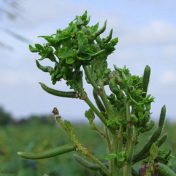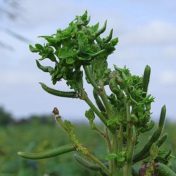A severe outbreak of phytoplasma disease has been reported in mungbeans from the Burdekin region. Symptoms of little leaf, phyllody (greening of flower structures) and puffy pod became obvious in mid-late October and have now affected a high incidence of plants in a 25 ha planting. Puffy pod affected plants typically remain green for longer than healthy mature plants. This… Read more »
Phytoplama has been reported in second flower flushes in mungbeans, and also in harvested mungbean regrowth! So far the overall incidence of phytoplasma has been lower than this time last year, but growers and consultants are urged to keep monitoring their crops for the first symptoms of this disease, and to report any outbreaks. Many January-planted mungbean crops are at… Read more »
Last summer saw unprecedented levels of phytoplasma in summer pulses/legumes (including chickpeas, mungbeans and pigeon peas) in all cropping regions in eastern and northern Australia from the Ord Irrigation area (WA), Burdekin/Atherton Tablelands (NQ), to central NSW. The most likely insect vector is the brown leafhopper Orosius orientalis, which has been detected in recent (2017) spring crops. While plantings of… Read more »
Phytoplasma (a specialised bacteria infecting plants) has been widely reported in spring-planted mungbeans from Central Queensland to North Western NSW (Moree and Narrabri) and all areas in between. Symptoms include masses of small deformed leaves, flowers and pods, plants remaining green at harvest, and possibly an increased incidence of puffy pod. While in previous recent summers, moderate to high levels… Read more »
A devastating disease was observed in several paddocks of soybean crops in the Branchview area of the Darling Downs in late autumn 2016. Almost 100 percent of plants were affected in some paddocks. The affected plants produced no, or very few filled pods and instead had a proliferation of tiny immature pods as shown in Photos 1 and 2. The plants… Read more »




